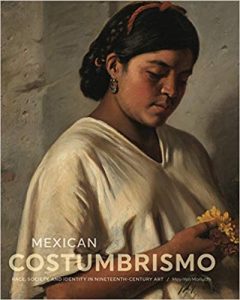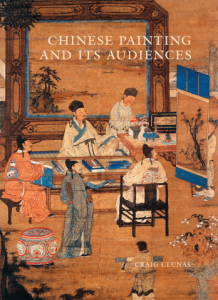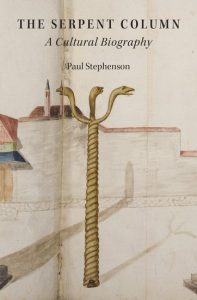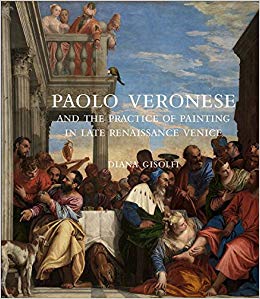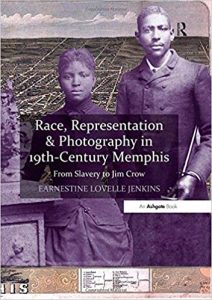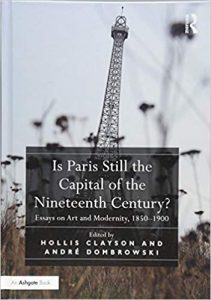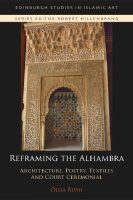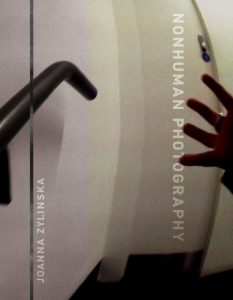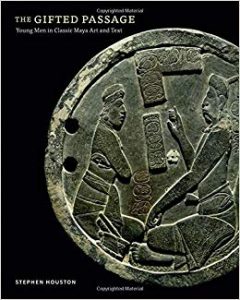CAA News Today
Member Spotlight: Nazar Kozak
posted by CAA — Apr 04, 2019
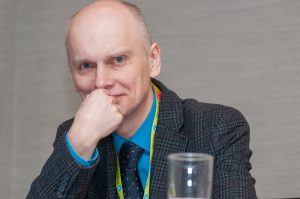
Nazar Kozak at the 2019 CAA Annual Conference. Photo: Ben Fractenberg
Up next in our Member Spotlight series, we are highlighting the work of Nazar Kozak, senior research scholar in the Department of Art History in the Ethnology Institute at the National Academy of Sciences of Ukraine, and an alumnus of the CAA-Getty International Program. Joelle Te Paske, CAA’s media and content manager, corresponded recently with Professor Kozak to learn more about his experiences at the Annual Conference, his current research, and his tips for scholars looking to extend their work internationally.
Joelle Te Paske: Hi Professor. Thanks for taking the time for our interview. So to begin, where are you from originally? What is the focus of your research?
Nazar Kozak: I am from Lviv, Ukraine, and I work in two fields simultaneously: medieval and contemporary art. The first one emerged from my interest in the cultural heritage of the region in which I live. My ongoing research in this field is focused on the sixteenth-century iconographic migrations of the Akathistos cycle across the post-Byzantine world from Venetian Cyprus in the South to the Tsardom of Muscovy in the North. Through this, I aim to discover artistic connections within this politically segmented realm that are not readily visible through archival data and thus to problematize nationalist narratives that have dominated Eastern European scholarship in the past. My second specialization emerged in recent years when issues of social justice and war came into the forefront in my country. I was driven to document and re-think artistic responses to the turmoil of events and through this to make my art history relevant to the times I am living through socially and politically. Currently, I am working on an article that explores how border art resists a global biopolitical divide.
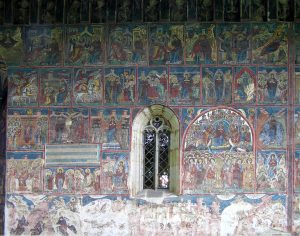
Akathistos cycle on the south facade of the Dormition Church in Humor, 1535. Photo: Nazar Kozak
JTP: What is your favorite thing about being a CAA member? Do you have a favorite memory?
NK: My favorite part of being a member is attending the Annual Conference. I remember the reaction of the audience to my talk at the Global Conversation session in 2017 when I shared my personal crisis in finding a motivation to continue writing art historical research when war broke out in my country and how I eventually found that motivation. The room was crowded and I remember the anxiety that I had before the session and the confidence I felt when I spoke and also during several moving conversations I had with attendees afterwards. That talk was published on the CAA website.
JTP: What is the most exciting part of your work currently?
NK: Currently and always the most exciting moment is when I realize that my work on a scholarly project is done; that is, when I can confirm my intellectual hypothesis and substantiate it with evidence that I genuinely believe to be true for now. This feeling, of course, does not last forever.
JTP: What would you say are some of the challenges?
NK: The major challenge is to find a sustainable answer for the Why question: Why am I writing a particular paper or monograph? And not just a random answer to tell others, but an answer I can tell myself and stick with, at least until I finish writing. The access to material and writing itself is a challenge, of course, but I think when you know your stake in it you can handle all the rest.
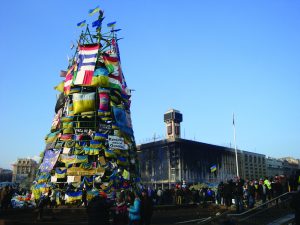
A view of Independence Square in Kyiv after violent clashes with the police during the Maidan Revolution, January 21, 2014. Photo: Borys Harasymiv
JTP: What is a favorite study you’ve worked on over the years? Any recommendations for our readers?
NK: Right now it is my article on art interventions during the Ukrainian Maidan revolution published in Art Journal in 2017.
I would recommend Decolonizing Nature: Contemporary Art and the Politics of Ecology by T.J. Demos, because it is a great piece of engaging scholarship and because art and ecology is a crucial issue that is relevant to us all.
For those who are interested in online resources on Byzantine art I would recommend The Digital Research Archive for Byzantium (DIFAB) and North of Byzantium.
JTP: What is your experience with Humanities Commons and the CAA-Getty program?
NK: I have used Humanities Commons several times as a platform for online discussions which have worked well as a supplement for in-person exchanges. Among other online platforms that I use is Academia.edu though I see its commercialization as controversial. The CAA-Getty International Program is the major vehicle that facilitates scholars from countries where art history has fewer resources than in West Europe or North America to bring their voice and to build their professional networks on the global scale. I participated in that program three times: first as a scholar and twice as an alumnus. This year I was selected to collaborate with the program’s director Janet Landay and the current CAA International Committee chair Pearlie Rose Baluyut to design and moderate the preconference colloquium on international topics in art history and I was honored to have that opportunity not only for my benefit but to contribute to the program as well. I might add that because of my work with the CAA-Getty program I have recently joined CAA’s International Committee, where I look forward to continuing to work on recruiting and interacting with international scholars.
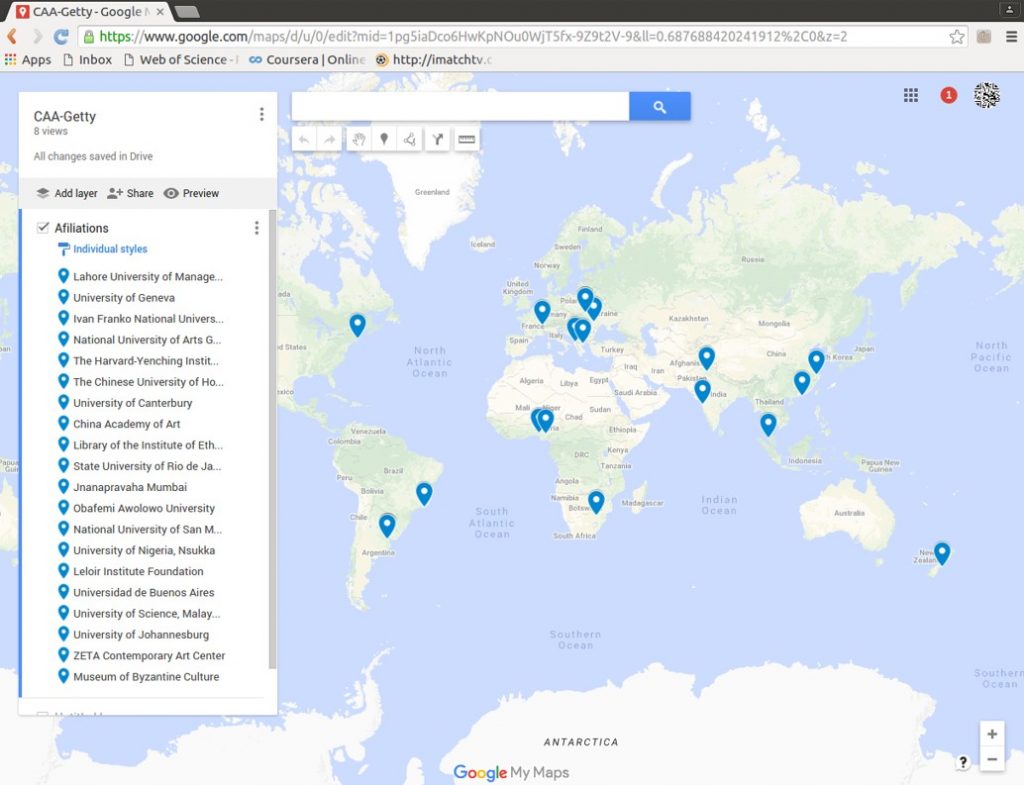
Map of home institutions of 2019 CAA-Getty International Program participants. Learn more.
Nazar Kozak is a senior research scholar in the Department of Art History in the Ethnology Institute at the National Academy of Sciences of Ukraine. Previously he also taught at the Medieval and Byzantine Studies Department at the Ivan Franko National University of Lviv. After receiving his PhD from the Lviv Academy of Arts in 2000, he spent a year in Greece under the auspices of the State Scholarships Foundation (IKY). Kozak is a recipient of research and publication grants from the American Council of Learned Societies (ACLS) and an alumnus of the CAA-Getty International Program. In 2016-2017, he was a visiting Fulbright Scholar in The Ukrainian Museum in New York. Kozak is the author of a monograph on image and authority in Kyivan Rus’ and articles dealing with Byzantine and post-Byzantine wall-paintings preserved in Ukraine. His ongoing research is focused on the sixteenth-century iconographic migrations of the Akathistos cycle across the post-Byzantine world. More recently, Kozak has also begun to work on topics in contemporary art. His article on the art interventions during the Ukrainian Maidan published in the Spring 2017 issue of the Art Journal received an honorable mention as a finalist for that year’s Art Journal Award.
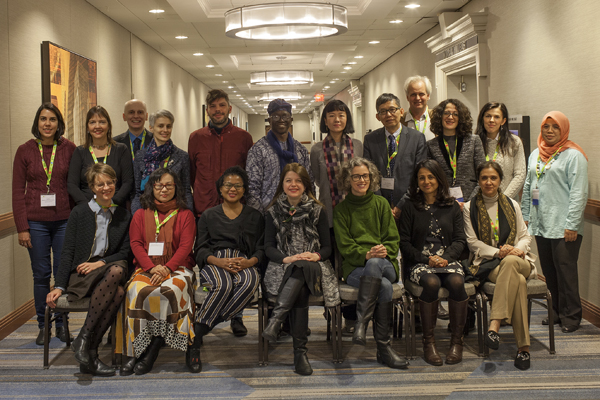
Nazar Kozak (third from top left) and fellow 2019 CAA-Getty International Program participants.
New in caa.reviews
posted by CAA — Mar 15, 2019
Ray Hernández-Durán reviews Mexican Costumbrismo: Race, Society, and Identity in Nineteenth-Century Art by Mey-Yen Moriuchi. Read the full review at caa.reviews.
Peter C. Sturman writes about Chinese Painting and Its Audiences by Craig Clunas. Read the full review at caa.reviews.
Fabio Guidetti discusses The Serpent Column: A Cultural Biography by Paul Stephenson. Read the full review at caa.reviews.
Thomas Dalla Costa examines Paolo Veronese and the Practice of Painting in Late Renaissance Venice by Diana Gisolfi. Read the full review at caa.reviews.
Meet Cali Buckley, CAA’s New Grants and Special Programs Manager
posted by CAA — Mar 14, 2019
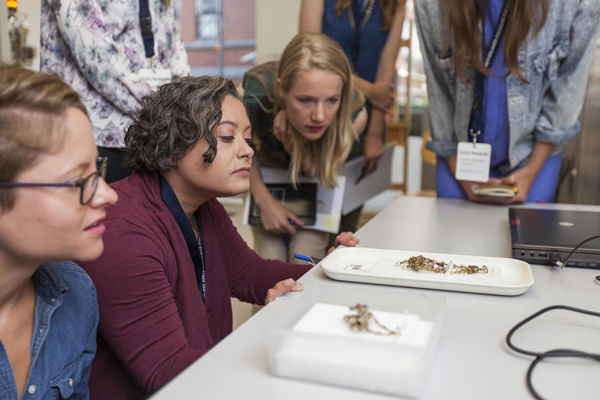
Cali Buckley takes part in the Rijksmuseum’s Museum Objects as Evidence: Approaches to the Material World Summer School, 2018. Photo: Thijs Gerbrandy
We’re delighted to introduce Cali Buckley, CAA’s new Grants and Special Programs Manager and RAAMP Coordinator, who began her full-time role in January after working part-time as the CAA Programs Assistant in 2017. She received her PhD from Penn State University on interactive anatomical models and their creation by craftsmen in the early modern era. Joelle Te Paske, CAA Media and Content Manager, spoke with her in late January to learn more about her research and her hopes for the Resources for Academic Art Museum Professionals (RAAMP) program, which provides publicly accessible resources to academic museum professionals.
Joelle Te Paske: Thanks for taking the time to chat, Cali. So to begin, where are you from?
Cali Buckley: I’m from Pottsville, Pennsylvania. It’s only about three hours from here. It’s north of Philly, best known for Yuengling beer which is the oldest brewery in America. That’s our claim to fame.
JTP: Good to know. And you worked with CAA a few years ago, correct?
CB: Yes, I moved to New York after my Fulbright and worked for CAA for six months as a programs assistant part-time while I was finishing my dissertation. Once I defended and graduated, I moved back to Germany.
I actually have long ties with CAA. Right out of college, I worked for Penn State University Press on art history books. I was able to actually attend CAA and talk to authors, and I worked at the Book and Trade Fair for about three years. It was fun. You can hear people talking about their wonderful book ideas. If I had more time, I would just sit around and see how people pitch these things because it’s fascinating.
I went to Penn State for journalism and then went into publishing right after graduating—I worked on history books and then got really into art history and thought about all the possibilities. Because I guess I had this much narrower idea of traditional art history. And then working on some of these new books really expanded my sense of what that could be.
JTP: That’s great.
CB: I knew some folks in our art history department at Penn State through the editorial board, and I started talking to them about the possibility of my doing my masters there. And I met one of my professors through an editor there. So I planned on going for my masters and then back into publishing, but I completely fell in love with it. I found some great topics, and I just kind of wanted to keep moving forward.
I started going to CAA as a graduate student, so no longer in the Book and Trade Fair. I was part of this group called The Graduate Student Association for Visual Culture. And we would apply for money from Penn State to get groups of us to go to CAA every year. So we would have this group caravan to CAA, all the art historians.
JTP: Sounds ideal.
CB: It’s wonderful. We created this Valentine’s Day tradition because CAA usually falls over Valentine’s Day. And we still get together on the 14th and watch our favorite movie and eat pizza.
JTP: Are you going to do it this year?
CB: Yes, yes, absolutely.
So I started with doing the Book and Trade Fair at CAA. Then I went as a graduate student, gave a talk at CAA in Chicago a few years back. And the same day participated in a roundtable in publishing. CAA’s been huge in my life.
JTP: I’d love to speak a bit about your research, too—early anatomical models and the control of women in medicine.
CB: Originally, when I went into publishing, I was doing weird research projects on interactive books and books as objects. And I used to give talks at Columbia to journalism students in the summer about how to create physical books and how it’s different from books online. How to work with the movement of books and do all these funny things that literary magazines were experimenting with. And then I found this sixteenth-century version of what I was talking about, in the form of an anatomical model.
These have become much more popular in the last ten years but some of these [models] had layers. So they were just images of the body with layers showing the different organs and systems. And that idea of movement and interactivity was fascinating—and a lot of them are inaccurate, even for their time, which makes them even more interesting.
There are all these different layers to audiences, whether you’re trying to highlight the accuracy, which a lot of these are not, or the visuality and the interactivity. And that seems to be more important.
Then I got into ivory models, which is a huge project of mine, creating a whole catalogue of them. That’s a big part of my dissertation.
JTP: Interesting.
CB: I found 180 in the world and I have new people emailing me every year. They’re a much bigger phenomenon than we thought and I’ve done quite a bit of research in Germany to pull these threads together and find out more about their history. I’ve been trying to bring these to light and hopefully I’ll have an article out soon.
JTP: That’s terrific. I’m curious—what is one of your favorite CAA conference memories?
CB: I think one of the great memories was actually an event connected to CAA where I was giving a talk with someone from The Art Institute of Chicago and they let us do a private showing of prints and different objects [at the museum]. Some of the prints were the actual interactive prints that I had worked on.
JTP: That’s always exciting, to be in the same room with objects you’ve studied.
Do you have a favorite exhibition you’ve seen recently?
CB: I just went to the Brueghel exhibition in Vienna and it was amazing. I mean, it was really well done and it went through both his history and paintings and a lot of his earlier drawings and sketches. But it also included a lot of the process to make the materials—some of the wooden planks and those sorts of thing that he used, and the process of painting and printing. That process stuff was really interesting. I think that should be in a lot more exhibitions.
JTP: I agree. My first job was as a registrar at a gallery and I can never quite divorce myself from “How much did the crate cost?”! Because you have a different sense of the process.
CB: Absolutely. I work a lot on materiality. I’m interested in the process of how a work was made, what it’s made of, and how the material affects it. I actually started taking a lot more art classes in different areas to get a feel for it.
I took a class in wax modeling with someone who does wax moulages and restoration. Moulages are generally medical things. So I essentially made a moulage using wax of some skin condition! That was a fun workshop. I was at the Narrenturm which is an old insane asylum in Vienna that now houses a pathological museum. And then you spend a couple of hours making these wax moulages. It was just such a bizarre and wonderful day.
JTP: That does sound bizarre and wonderful.
So, thinking forward to your work with RAAMP, what do you find the most exciting part of that resource?
CB: I’m excited to be [at CAA] and working on a diversity of projects so that I get that bigger, that broader umbrella of what’s new and exciting outside of my little area of the research world. Part of that is the RAAMP program, which really allows people in various facets of the academic and museum worlds to share experiences and have discussions about issues facing those institutions—and those who they serve—today. I love the idea of having meetings and sharing discussions online, because that way they are more accessible. Our Coffee Gatherings are like afternoon meetings at a café with a small audience that can discuss matters in a casual way, but they are also recorded now so students can always watch these later to gain insight into particular matters. The video practica are similar, but more streamlined with one person discussing a specific topic. I can’t wait to get more Coffee Gatherings together because those small group discussions can be really valuable.
JTP: How do you see of the role of academic art museums moving forward?
CB: Academic art museums are as integral as ever to education, but they are facing different issues as time goes on while also dealing with age-old dilemmas. They need to learn how to use the latest technology and how to deal with the latest controversies over artwork, but they also need to engage students. The whole idea of RAAMP is to provide resources for academic art museums to tackle these problems. Part of that is providing a network of professionals who share their expertise.
I do think that museums have to be aware of the social environment and how to contend with criticism. Our session at the 2019 conference allows us to open up this topic to see how artists and professionals deal with some very serious issues of artwork being interpreted as offensive. Artwork is inherently open to interpretation, so I think it’s important to discuss how museums act as mediators to a degree—and how their role is balanced with their place in an academic institution.
I should add that one of my favorite teaching experiences was being able to introduce first-year students to the Palmer Museum of Art at Penn State and asking them to describe the giant [Helen] Frankenthaler painting we had hanging there. There’s nothing quite like it when a student realizes that they have history right in front of them.
CWA Picks for March 2019
posted by CAA — Mar 11, 2019
CAA’s Committee on Women in the Arts selects the best in feminist art and scholarship to share with CAA members on a monthly basis. See the picks for March below.
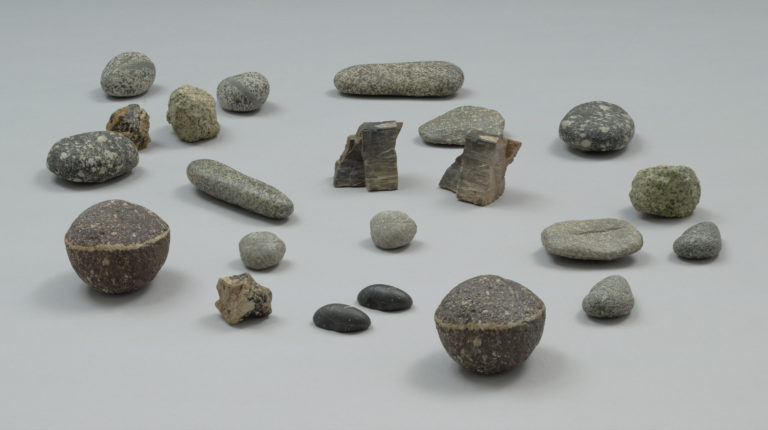
Vija Celmins, To Fix the Image in Memory I-XI, 1977-82; The Museum of Modern Art, New York, gift of Edward R. Broida in honor of David and Renee McKee; © Vija Celmins; photo: courtesy Matthew Marks Gallery. On view at SFMoMA through March 31st.
Judith Godwin: An Act of Freedom
February 14 – March 16, 2019
Berry Campbell Gallery, New York
Judith Godwin: An Act of Freedom contributes to the important revisionist history on the women of Abstract Expressionism with the presentation of twenty-three gestural canvases produced from 1954 through 2007. A native of Suffolk, Virginia, Godwin (b. 1930) attended Mary Baldwin College in Staunton (1948-50) and completed her undergraduate degree in 1952 at Richmond Professional Institute of the College of William and Mary (now Virginia Commonwealth University). She moved to New York in 1953, where she was invited to attend frequent dance classes and performances by Martha Graham, with whom she established a lifelong friendship. She also studied briefly with Will Barnet and Vaclav Vytlacil at the Art Students League, followed by classes with Hans Hofmann in Provincetown, MA, and in the fall 1954 at 52 West Eighth Street. Inspired by Hofmann’s color principles, Godwin’s emerging abstractions in the mid-1950s, many on view here, display a tightly structured organization of planar elements that develop into expansive and sweeping arcs, angles, and spatial breaks across the painterly surface. An interesting comparison is Japanese painter Kenzo Okada (1902-82), another formative association for Godwin encouraging her investigations in Zen Buddhism. Godwin’s paintings were included in the important traveling exhibition, Women of Abstract Expressionism that originated at the Denver Art Museum in 2016.
VIJA CELMINS: TO FIX THE IMAGE IN MEMORY
December 15, 2018 – March 31, 2019
San Francisco Museum of Modern Art
The first retrospective of Vija Clemins in North American in more than 25 years, this exhibition presents over 140 small scale, exquisitely detailed paintings, drawings, and sculptures of the physical world by the American-Latvian artist. Living and working in New York since 1981, Celmins’ early work was inspired by Pop Art, painting realistic depictions of everyday objects, followed by drawings and paintings of newspaper photographs. Her Untitled (Big Sea) series in the 1970s, depicting the ocean texture completely filling the picture plane, unbroken by any horizon or secondary life or object, brought her acclaim as she developed her meticulously thorough technique. Her intention more about the process than the photographic reflection or landscape aesthetic, the works’ texture and character present a fascinating distraction, opposing romantic cliché.
ROSE ENGLISH. FORM, FEMINISMS, FEMININITIES
March 1 – April 13, 2019
Richard Saltoun Gallery, London
Since March 2019 Richard Saltoun Gallery in London is dedicating its annual programme to women, as part of their mission to support female artists who are under-recognized and under-represented. This inaugural exhibition celebrating the Gallery’s commitment to protest gender inequality in the art world, showcases Rose English’s works from the earlier stages of her career. The exhibition includes a range of artworks from 1970s and early 1980s demonstrating the richness of English’s unique artistic vocabulary, her curiosity and willingness to experiment with processes and materials, and her versatility as an artist eager to engage with photography, ceramics, collage, film, installation and performance. Her interest in politics, social issues, aesthetics, philosophy and popular culture can be traced in her early works. What is particularly interesting, is the artist’s subversive understanding of feminism and femininity which she explores through challenging and interweaving diverse forms, their conventions and histories. Plato’s Chair (1983) exhibited in the final room of the gallery is one of her most important early monologue performances staged at the Western Front in Vancouver, Canada in 1983.
Erika Verzutti: Mutations / Creations 3
February 20 – April 15, 2019
Centre Pompidou, Paris
Mutations is the first monographic exhibition in Europe of Erika Verzutti, the Brazilian artist (b. 1971, São Paulo) known for her vital exploration of the materialization and facture of sculptural forms in bronze, ceramic, cement and papier-mâché. Occupying the entirety of Gallery 3, Verzutti’s provocative sculptures and reliefs, often animalistic, vegetal, and botanical abstractions, are here conceived as “families” or generative groupings and “conversations,” such as Tarsila, an homage to the brilliant painter and “mother” of Brazilian modernism, Tarsila do Amaral, or The Brasilia Family, a title conjuring the extraordinary industrialization of the new capital city in postwar Brazil. A central object embodying a massive swan’s shapely form evokes matrilineal sources and tribal connectivity. In relationship to the rational, geometric panels of Brazilian Concretism in the 1950s or the gestalt ideals of Neo-Concretist “non-objects,” Verzutti’s playful, sardonic and feminist gestures invite new and welcome readings on texture, materiality, and opticality.
DINOSAUR IN THE DOLLHOUSE
January 31 – April 19, 2019
Carlow University Art Gallery, Pittsburgh
This process and collaborative oriented exhibit includes paintings by artists Sarah Jacobs, Kristen Letts Kovak, and Katherine Tzu-Lan Mann around legacy, possibility and evolving context. One individually completed painting by each artist is complemented by another that was influenced by the paintings by the other two artists. Moreover, the trio will create a collaborative painting in the gallery during the exhibition’s run that will be finished by the end. Katherine Tzu-Mann’s expansive, expressive colorful paintings explore how painting can “capture flux, abundance, waste, fertility, and the collision and collusion of diverse forms” from material, to process to their animated result of shapes, moving lines and colors. Also rich in movement and hue, Kristen Letts Kovak’s paintings seem to take more botanical form, if imagined, as the artist explains her more intuitive approach, her paintings are “both records of my perceptions, and independent objects for observation.” Sarah Jacobs’ process is pattern-driven, meticulously hand-painted, bright and complex work that relates to human vulnerability. The artists share a mentor, who provided impetus for the title reflecting artists’ perhaps seemingly random yet purposely juxtaposed choices.
She Persists: A Century of Women Artists in New York, 1919-2019
January 22 – December 19, 2019
Gracie Mansion, New York
What does it mean to make a difference while residing in “The People’s House?” First Lady of New York City Chirlane McCray embodies strident activism in her support of this important exhibition at Grace Mansion, the official residence of the Mayor and his family. This smart installation of 44 modern and contemporary women artists marks a century of persistence since suffrage and shows 60 artworks by women who represent diverse origins and cultural positions intersecting life and culture in New York City. Curator Jessica Bell Brown brings together photographs, objects, archival materials, and artworks documenting diverse forms of political resistance and power struggles (LGBTQ and AIDS awareness, for example) and art historical and proto-feminist interventions in the twentieth-century canon (Abstract Expressionist modern women, for instance), all of which thematically explore ideas contending with “complicated histories, the body as battleground, picturing people, and expanding abstraction.” She Persists presents an extraordinary range of artists: early modernists and social realists Florine Stettheimer, Isabel Bishop, and Theresa Bernstein; photographers Berenice Abbott, Ruth Orkin, Perla de Leon and Consuelo Kanaga; video and performance artists Mierle Laderman Ukeles, Martha Rosler and Ana Mendieta; and postwar abstractionists Betty Parsons, Helen Frankenthaler, Grace Hartigan, Lee Krasner, and Carmen Herrera. Kara Walker, Simone Leigh, Elizabeth Catlett, Augusta Savage, and Faith Ringgold represent broad proposals on African-American narratives. Shirley Chisholm, the Brooklyn-born Congresswoman, summarizes the rallying cries for women’s rights in her 1974 speech: “Forget traditions! Forget conventionalisms! Forget what the world will say whether you’re in your place or out of your place Stand up and be counted.”
New in caa.reviews
posted by CAA — Mar 01, 2019
Katherine Field reviews Race, Representation & Photography in 19th-Century Memphis: From Slavery to Jim Crow by Earnestine Lovelle Jenkins. Read the full review at caa.reviews.
News from the Art and Academic Worlds
posted by CAA — Feb 27, 2019
Want articles like these in your inbox? Sign up: collegeart.org/newsletter
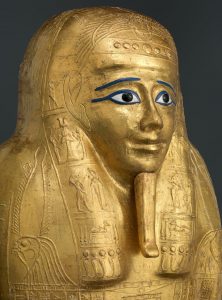
The Met announced it will return a recent acquisition—a golden-sheathed coffin from the 1st century BC—to Egypt. Photo: Met Museum
Met Museum to Return Prize Artifact Because It Was Stolen
The museum has stated it will “review and revise” its acquisitions process. (New York Times)
Five First Steps for Making Your Events More Accessible
Evergreen resources to make your events more accessible. (NYFA)
It Keeps You Nice and Disposable’: The Plight of Adjunct Professors
Part-time adjunct instructors represent two-fifths of all faculty at US colleges and universities. (Washington Post)
On What It Takes to Sustain a Creative Life Financially
“I knew plenty of others had figured out how to do it before me, but regrettably, I had no window into their process. This essay is an attempt to share what it took.” (The Creative Independent)
Dear Faculty: You Matter More Than You Know
True mentorship is about more than making students feel cared about and supported. It involves making them work hard, too. (Inside Higher Ed)
Art Museums Need to Address Colonialist Theft—Not Diversity
MoMA announced it will close this summer to include more works from artists of color, but activists say this does little to reconcile centuries of exploitation. (Broadly)
New in caa.reviews
posted by CAA — Feb 22, 2019
Elizabeth C. Mansfield reviews Is Paris Still the Capital of the Nineteenth Century? Essays on Art and Modernity, 1850–1900, edited by Hollis Clayson and André Dombrowski. Read the full review at caa.reviews.
Abbey Stockstill writes about Reframing the Alhambra: Architecture, Poetry, Textiles and Court Ceremonial by Olga Bush. Read the full review at caa.reviews.
Elizabeth A. Kessler discusses Nonhuman Photography by Joanna Zylinska. Read the full review at caa.reviews.
Matthew Looper examines The Gifted Passage: Young Men in Classic Maya Art and Text by Stephen Houston. Read the full review at caa.reviews.
Affiliated Society News for February 2019
posted by CAA — Feb 05, 2019
Affiliated Society News shares the new and exciting things CAA’s affiliated organizations are working on including activities, awards, publications, conferences, and exhibitions.
We’re seeking new organizations to join CAA’s Affiliated Societies. Click here to learn more.
New Media Caucus
Media-N: Journal of the New Media Caucus
Recent Publication Vol 15 No 1 (2019): Autonomous Art Systems
https://iopn.library.illinois.edu/journals/median/issue/view/7
For this issue, guest editors Nick Bontrager and Adam Fung invited submissions about the use of “Autonomous Art Systems.” Submissions included work on tethered and untethered systems of making, autonomous vehicles, and related programming in creative fields of study. Relevant subjects included: artworks that address concepts of drones or surveillance as subject or form; the influence of emerging technologies on studio art practices; or critical/historical analysis of the entanglement of art and technology.
NMC Events at CAA, 2019
2/13/19, 10:30 PM-12:00 PM, New York Hilton Midtown, Rendezvous Trianon, NMC Panel: Reframing Innovation: Art, the Maker Movement and Critique, chairs: Victoria Bradbury Suzy O’Hara
2/13/19, 12:30 PM-1:30 PM, New York Hilton Midtown – 2nd Floor – Sutton North, NMC Business Meeting: open to members and non-members alike.
2/13/19, 2:00 PM-3:30 PM, Media Lounge, Data Détournement, organized by Derek Curry (Northeastern University) and Jennifer Gradecki (Northeastern University).
2/14/19, 2:00 PM-3:30 PM, Media Lounge, Digital Art and Activism, organized by Morehshin Allahyari and Angela Washko (Assistant Professor of Art, Carnegie Mellon University)
2/14/19, 8:00 PM-9:30 PM, Hunter College MFA Building, 205 Hudson Street, New York, NY 10013, NMC Member Showcase, hosted by Christina Freeman, Department of Art & Art History, Hunter College of the City University of New York
2/15/19, 2:00 PM-3:30 PM, Media Lounge, Good Artists Torrent, Great Artists Fork, organized by Nick Bontrager (Texas Christian University) and Taylor Hokanson (Columbia College Chicago)
For more information on the above, and information on additional panels involving NMC members, consult the following list: http://www.newmediacaucus.org/caa-2019-in-nyc/
Border Control
The New Media Caucus proudly announces the 2019 Symposium and Exhibition, Border Control, at the University of Michigan, Penny W. Stamps School of Art and Design and the Stamps Gallery.
SYMPOSIUM + EXHIBITION
SUBMISSIONS ACCEPTED THROUGH FEB. 28, 2019
Hosted by the University of Michigan, Penny W. Stamps School of Art and Design and the Stamps Gallery. Ann Arbor, MI
EXHIBITION DATES: SYMPOSIUM DATES:
9/20/19 – 11/10/19 9/19/19 – 9/22/19
GUEST CURATOR:
Allison Collins, Media Arts Curator, Western Front
Borders and boundaries, both tangible and ephemeral, are closely tied to the ways in which humanity has made sense of the world and of our historical place in it. Yet historically, borders have figured as sources of tension and contestation as much as legibility and certainty. In our current moment, the promise of reassurance offered by borders and boundaries is being radically undermined and challenged by processes such as climate change, rapid techno-scientific development, and the unraveling of traditional hierarchies and stereotypes, as well as of accepted notions of demographic, political and economic boundaries.
How do you navigate borders in your own practice or research?
The New Media Caucus seeks to bring together artists and scholars who critically engage the topic of borders and boundaries through their practice and research.
http://bordercontrol.newmediacaucus.org
International Sculpture Center
Sculpture has launched a newly redesigned magazine with our Jan/Feb 2019 issue! Subscribe to Sculpture and follow us for more updates.
Red Grooms & Seward Johnson will be awarded with the 2019 Lifetime Achievement Award on April 18, 2018 at a Gala in NYC.
The Call For Panels is now open for the 29th International Sculpture Conference – the deadline to apply is March 14.
The ISC invites you to nominate up to 3 talented sculpture students for the Outstanding Student Achievement in Contemporary Sculpture! Head to our link now and join as an ISC University level member to get started
Students who are interested should talk to their professors about getting involved. To find out more about the program please visit the website http://www.sculpture.org/StudentAwards/2019 or email studentawards@sculpture.org
FATE
FATE (Foundations in Art: Theory and Education) News: http://www.foundations-art.org/
Join us during CAA 2019 for FATE’s Affiliate session, “Get Up, Stand Up: Contingent Faculty and the Future of Higher Education in the Visual Arts,” Friday, Feb 15, 2019, from 6 – 7:30pm in the Bryant Suite at the New York Hilton Midtown. Chaired by Naomi J. Falk and Richard Moninski, with panelists Christopher Williams, Mark Stemwedel, and Laura Rodman Huaracha. Increasingly, tenure-track positions disappear, contingent faculty numbers swell, and those who are left standing teach more classes. Is this sustainable and how do we support each other? https://caa.confex.com/caa/2019/meetingapp.cgi/Session/2304
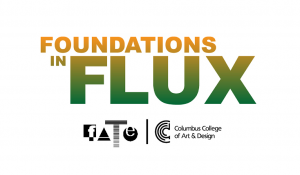 Register for FATE’s 17th Biennial Conference, “Foundations in Flux,” will be hosted by Columbus College of Art & Design in Columbus, Ohio on April 4th-6th, 2019. Registration includes Breakfast & Lunch for each day of the conference. https://www.foundations-art.org/conference
Register for FATE’s 17th Biennial Conference, “Foundations in Flux,” will be hosted by Columbus College of Art & Design in Columbus, Ohio on April 4th-6th, 2019. Registration includes Breakfast & Lunch for each day of the conference. https://www.foundations-art.org/conference
Foundations in Flux will host various workshops led by FATE members during the conference on Friday April 5th. Workshop sessions have limited numbers of seats & participants must register in advance, there are NO ADDITIONAL FEES to participate in these workshops. All workshops will be held on the campus of CCAD. All seats are on a first-come basis and some workshops will require materials to be supplied by the attendee. Please read all workshop details below before making your selection(s). For more info and to register: https://docs.google.com/forms/d/e/1FAIpQLSdKwlrpTANzrgZICqL0LzyvG8Qwc3x_yw4ABLo2z7zu3dvDUw/viewform
Positive Space is FATE’s bi-monthly podcast providing opportunities for those passionate about art foundations to discuss and promote excellence in the development and teaching of college level foundations in art & design studio and history classes. To check out the latest episode, featuring FATE President, Valerie Hanks, discussing her recent workshop about discomfort and empathy in the classroom, visit: https://www.foundations-art.org/positive-space
If you have podcast ideas, contact us! Positive Space has a phone number: 904-990-FATE. Give us a call & record a message today!
American Institute for Conservation
Please join us at the 2019 AIC Annual Meeting being held at the Mohegan Sun, located in Uncasville, CT, May 13-17. With over 1,400 attendees, the AIC Annual Meeting is the largest international conservation and collection care conference held in North America. Visit our Annual Meeting webpages to see the online schedule and learn about the nearly 200 talks and events. Some highlights of the 2019 meeting include a new Opening General Session featuring TED-style talks, hundreds of specialty talks, and engaging lunch programing.
The Mohegan Sun, centrally located in New England, offers a 4-star quality hotel experience at a low nightly rate of $139 for AIC Annual Meeting attendees. We also have a block of student rooms starting at $98 per night. Getting to the Mohegan Sun is easy. Those located between Washington DC and Boston can drive or take Amtrak. AIC is also running direct buses from New York City and Boston. For more information on our host hotel, view the accommodations pages.
The proximity to major East coast cites allows AIC to offer workshop and tours all over New England during our pre-session, May 13-14. Visit the online schedule to view our pre-session offerings.
We welcome you to register now for the 2019 AIC Annual Meeting!
Visual Resources Association (VRA)
Tools and Trends in Visual Resources
The Visual Resources Association is using a scheduled business meeting at the annual College Art Association conference to share information about some of the tools that curators are using to enhance and manage digital image collections and discuss new trends in the field of visual resources and art librarianship.
Three speakers will be presenting their work in these areas:
Cataloging at Artstor: A New Look at Tried and True (and some AI) Strategies
Lisa Gavell, Senior Manager of Image Content at Artstor
Maximizing Metadata: VRA Embedded Metadata Tools
Marcia Focht, Curator of Visual Resources at Binghamton University
Images as Research Data
Jasmine Burns, Visual Resources Metadata Librarian at Cornell University and Chair of the Upstate New York Chapter of VRA.
Please join us for provocative presentations with time for questions and discussion on Friday, February 15th, 2019, in the Morgan Suite at the New York Hilton Midtown, from 12:30 to 1:30 pm.
This event is free and open to the public, so you do not need to be a CAA member or to register for the conference to attend this business meeting. If you wish to attend regular sessions, the book and trade fair, or other CAA conference activities, you must register. Advance registration for the full conference ends on Jan 30th, 2019 (only 3 days left), but single timeslot and day passes may be purchased onsite (not available in advance).
For questions, please contact:
Maureen Burns, IMAGinED Consulting & VRA CAA Affiliate Representative
moaburns@gmail.com or 310-489-3792
SECAC
The Call for Papers for SECAC 2019 in Chattanooga is open at https://secac.secure-platform.com/a/solicitations/home/5.
SECAC 2018: 74th ANNUAL CONFERENCE
In October, SECAC met for the 74th time in Birmingham, Alabama, hosted by the University of Alabama at Birmingham. Over 120 sessions were held, and 561 members representing 284 institutions attended. In its eighth year, participation in the SECAC mentoring program remained high with 40 members meeting as mentors and mentees.
Highlights of the conference included the SECAC 2018 Annual Juried Exhibition at UAB’s Abroms-Engel Institute for Visual Arts and a keynote address at the Birmingham Museum of Andrew Freear of the Rural Studio.
At the annual business meeting SECAC President Sandra Reed of Marshall University introduced new members of the Board of Directors: Alabama, Wendy DesChene, Auburn University; Florida, Jeff Schwartz, Ringling College of Art and Design; Kentucky, Eileen Yanoviak, Carnegie Center for Art and History; Louisiana, Jill Chancey, Nicholls State Univeristy (continuing); North Carolina, Kathryn Shields, Guilford College; and At Large #3 Claire Kovacs, Augustana College.
SECAC 2019 will be hosted by the University of Tennessee at Chattanooga, October 16-19. Calls for presentations, juried exhibition entries, and award applications will be published on the SECAC submissions site at https://secac.secure-platform.com/a in early 2018.
AWARDS PRESENTED AT SECAC 2018
The SECAC Artist’s Fellowship, a $5,000 prize, was awarded to photographer Karen Graffeo, Professor of Art at the University of Montevallo, author and photojournalist Julio Larramendi, photographer and editor at Ediciones Polymita in Cuba, photographer Sonja Rieger, Professor of Photography at the University of Alabama at Birmingham, and Alabama-based photographer and filmmaker Carolyn Sherer. Their proposed exhibition, My Other Body: Trans-Culture, Transgender Cuba/Alabama, will be on view at SECAC 2019 in Chattanooga, Tennessee.
Andrew Wasserman, Visiting Assistant Professor at the University of North Carolina at Greensboro, won the 2018 Levin Award for his project Bang! We’re All Dead! The Places of Nuclear Fear in 1980s America.
The 2018 SECAC Award for Excellence in Teaching was presented to Wendy DesChene, Professor of Art at Auburn University.
The 2018 SECAC Award for Excellence in Scholarly Research and Publication was awarded to Olga U. Herrera, Director of the Washington Office of the Inter-University Program for Latino Research (IUPLR) headquartered at the University of Houston, for American Interventions and Modern Art in South America, University Press of Florida, 2017.
The 2018 SECAC Award for Outstanding Exhibition and Catalog of Historical Materials was presented to Keri Watson for In the Eyes of the Hungry: Florida’s Changing Landscape, exhibited at the UCF Art Gallery and the Terrence Gallery at the Orlando City Hall in 2017.
The 2018 SECAC Award for Outstanding Exhibition and Catalog of Contemporary Materials was given to Vesna Pavlović, Associate Professor of Art at Vanderbilt University, for the exhibition Vesna Pavlović’s Lost Art and its catalog edited by Pavlović and Morna O’Neill.
Thirty-four graduate students received Gulnar Bosch Travel Awards: Virginia Badgett, University of California, Santa Barbara; Gráinne Coughlan, Dublin Institute of Technology; Stephanie Crawford, Rutgers University; Erin Davenport, University of North Carolina at Chapel Hill; Julia Detchon, University of Texas; Parissa Farmoudehyamcheh, Georgia Southern University; Dilmar Mauricio Gamero Santos, Tyler School of Art, Temple University; Elyse D. Gerstenecker, University of Virginia; Caroline Gillaspie, The Graduate Center, CUNY; Amy Catherine Hulshoff, University of New Mexico; Manami Ishimura, Texas A&M Corpus Christi; Ally Johnson, University of Illinois at Urbana-Champaign; Tacie Jones, Virginia Tech University; Holly Kelly, University of Tennessee, Knoxville; Sharon Khalifa-Gueta, Ben Gurion University of the Negev; Patricia Lagarde, Tulane University; Mia Laufer, Washington University in St. Louis; Kimiko Matsumura, Rutgers University; Mary Mazurek, IDSVA ; Reed O’Mara, Case Western Reserve University; Ellie Perendy, Baruch College; Kathleen Pierce, Rutgers University; Catherine Popovici, The University of Texas at Austin; Ali Printz, Tyler School of Art, Temple University; Lily F. Scott, Temple University; Roberta Serra, Université Paul Valéry; Lauren Elizabeth Shea, University of Illinois at Urbana-Champaign; Jeff Siemers, IDSVA; Lauryn Smith, Case Western Reserve University; Tracy Spencer Stonestreet, Virginia Commonwealth University; Sarah Tietje-Mietz, Syracuse University; Vanessa S. Troiano, The Graduate Center, CUNY; Angela Whitlock, IDSVA; and Hayley Woodward, Tulane University.
Juror Peter Baldaia, Director of Curatorial Affairs at the Huntsville Museum of Art, selected Over There To Here (Gatlinburg), 2018, by Stacy Isenberger, University of Idaho, as Best in Show at the SECAC 2018 Annual Juried Exhibition. He also recognized five participants with Juror Awards: Joshua Brinlee, University of Mississippi, for Self-Portrait as Provider, 2017; Lily Kuonen, Jacksonville University, for Hewn, 2017;
Jessica Mongeon, Arkansas Tech University, for Drunken Trees: Permafrost Melts, Leaving Uneven Ground, 2017; Duane Paxson, Independent Artist, for Denying Dendera, 2018; and John Douglas Powers, University of Tennessee–Knoxville, for Terra Nuova, 2017.
EAHN
The EAHN wishes to draw attention to the three calls for proposals described below, all organized by EAHN’s Urban Representations Work Group, for the conference “The Global City: Urban Condition as a Pervasive Phenomenon” organized by the A.I.S.U. (Associazione Italiana di Storia Urbana) in Bologna, 11-14 September 2019.
The deadline for submitting abstracts has been extended to February 10th.
Abstracts indicating name, affiliation, email address, brief cv, and a description of the proposed topic of no more than 2000 characters should be sent both to the chairs of the session and to the conference organizers (congresso@storiaurbana.org) using the form found on the conference website http://www.storiaurbana.org/index.php/en/component/content/article/9-congressi/1131-bologna-2019-call-for-paper-uk
Session 3-5 “The Photo-book and the City”
The term ‘photo-book’ was coined in the 1920s by László Moholy-Nagy and went on to define a popular genre within 20th-century visual culture. While this genre emerged within the ‘New Vision’ of the inter-war period, it has a broader history that goes beyond the modernist avant-gardes. What role did this unique form of publication play within the history of urban representation? The aim of the session is to focus on the photo-book as an instrument for reading, analysing, and interpreting cities through a curated sequence of images. There is a long cultural and artistic history of these illustrated books, spanning from the late-19th to the early-21st century, which calls for comparative investigation. A tentative list should include celebrated examples, ranging from Alvin Langdon Coburn’s works inspired by Japanese view-making cultures (London 1909; Edinburgh 1909; New York 1910) to seminal books by Brassaï (Paris de nuit 1932), Berenice Abbott (Changing New York 1939), Horacio Coppola (Buenos Aires 1936) and William Klein (New York 1956; Rome 1959), but we are equally interested in less-known publications. Attention will also be given to by the work of photographers trained as architects who used the camera to capture specific qualities of urban space, such as Norman Carver (Italian Hilltowns 1979) and Gabriele Basilico, whose observations of cities around the world (Milan; Beirut; Berlin; Moscow; Istanbul) were the subject of carefully curated volumes. There is a history here that awaits to be written; one that is made all the more significant by the recent use of photo-books to preserve the narrative of urban campaigns stretching over decades (e.g., works by Martin Parr and Garry Badger published by Phaidon). Gradually, as with other photographic trends, this type of representation has been taken up by contemporary artists, historians, architects and urban designers for a variety of urban explorations. We encourage participants to propose case-studies as well as reflective papers focusing on photo-books across the history of photography – from its origins to the latest digital developments. Contributions that address the role of various figures involved in the production, circulation, and reception of these publications (e.g., photographers; editors; publishers; etc) are also welcome.
Chairs: Davide Deriu d.deriu@westminster.ac.uk; Angelo Maggi amaggi@iuav.it
Session 6-4 “Reading the City’s Histories Through Visual Documents”
Every city contains multitudes, presenting a collective artifact made up of innumerable places and lived narratives. Most present-day cities also overlay multitudes, covering or transforming earlier iterations of themselves. Our knowledge of those older layers, of urban landscapes since recast, quickly surrenders to the mortality of personal memory. We then come to depend heavily on the persistence of physical artifacts that capture fragments of the past city, whether through survivals and traces in the present-day built landscape or through records — textual, visual, and sometimes even three dimensional — of those largely supplanted deeper layers of the urban palimpsest.
But the city is a big and complicated artifact, and every such representation must be a purposeful distillation, begging questions of the part and the whole, and of choice. Each favors some kinds of information over others, and all demand a considered examination of the lens adopted by their creators, retrospectively framing the visual document in the context of agency, motives, models, and expected function. At the same time, even as we are conscious of such filtering frames, we want to ask what they tell us about their subject, as they offer posterity some of our best evidence of these places in time. They allow us to better see and read the built landscapes they portray as patterns of forms, as socio-economic artifacts, as settings of living and working and gathering, of entrepreneurial ambitions and communal organization, across the globe and through history.
For this session, we especially invite contributions that look to and interrogate visual documents that capture lost aspects of the city of both distant and recent history at a range of scales — from detailed surveys of common building forms to purposefully selected sets of views, from closely transcribed plans and streetscapes of whole blocks and neighborhoods to maps of larger spatial networks and depictions of a city as a whole — that offer us insights on both that city and our own vantage point, in terms of our intentions and responses, in our looking at and to it.
Contact person: Anat Falbel anatfalbel@uol.com.br
Chairs: The EAHN Interest Group “Urban Representations” (organized by group members Jeffrey Cohen, Anat Falbel, Min Kyung Lee, Nancy Stieber)
Session 6-6 “Stories We Tell: Narratives of Urban Space”
Architectural sites as tourist attractions challenge the histories and memories of the urban collective. The city beckons the potential visitor (both tourist and local alike) through the aestheticization and cultural branding that serve, particularly through pervasive mediatizations, to narrativize urban space that may be in contrast to, or stacked amongst, stories of place. This session will engage an assortment of pressing questions about the relationship of architecture to tourism and memory specifically to position concepts of demolition, preservation, heritagization and new construction within urban (geopolitically-shaped) sites, for no site is detached from place; no touristic visit can effectively be accomplished without considering — in some measure — the story of a place and the memories it holds for all those who dwell or pass through it. No guidebook is disentangled from interpretive memories and stories that contribute to how tourists come to learn about a site. Questions such as whose memories become the stories of a tourist’s encounter with a place, or how do we consider the terms heritage or heritagization within the context of placemaking and memory stories, will be discussed. Finally, what constitutes the memory or (competing) memories of a place in order for it to be preserved (and subsequently branded for a tourist economy)?
Chair: Shelley Hornstein shelleyh@yorku.ca
ATSAH
NEWS FROM ASSOCIATION FOR TEXTUAL SCHOLARSHIP IN ART HISTORY
AWARDS for Students and Scholars
In commemoration of our 30th anniversary, ATSAH plans to offer two awards: one prize for the best article by an emerging scholar (no higher than Associate level). The topic may range from classical to Pre-Raphaelite art, reflecting the aims of ATSAH. The second is a small travel grant for junior scholar presenting a paper an ATSAH session.
The board of ATSAH selects these awards.
For further data, contact:
Liana Cheney, PhD, President of ATSAH
Liana_Cheney@uml.edu
ATSAH Session at CAA 2019
Member’s publications
Special Edition in Iconocrazia Vol 13 – 2018
Art, Astronomy, Politics, and Religion
Liana De Girolami Cheney
Giorgio Vasari’s Moral Virtues in the Oratory of the Compagnia del Gesù at Cortona: Physical and Metaphysical Power
Andrzej Piotrowski
Politics, Architecture, and the Historiography of Denial in Poland
Brian D. Steele
Force Constrained: Hercules in Sixteenth-Century Venice
Charles Burroughs
The Graces and Political Order in the Renaissance Imaginary
Damiano Acciarino
Iconologia del Fato nel Rinascimento
Giangiacomo Gandolfi
Cosimo de’ Medici, Paolo Toscanelli e il Cielo dei Magi: una nuova ipotesi per gli Emisferi Celesti Fiorentini
Jennifer Bates Ehlert
Questioning the Oracle: Jacek Malczewski’s Pythia series and World War One
Lynette M.F. Bosch
Interpreting and Dating Michelangelo’s Crucified Christ for Vittoria Colonna: Fra Ambrogio Catarino Politi And St. Paul
Sarah J. Lippert
Egypt and Napoléon Displaced
Cassandra Sciortino
Armand Point’s St.Cecilia & the Painters of the Soul: Bridging Art & Life in Fin de Siècle France
Liana De Girolami Cheney
Edward Burne-Jones’s The Mirror of Venus: Physical and Intangible Female Beauty in Journal of Literature and Art Studies 9, no. 1 (January 2019):1-28.
International Association for Word and Image Studies (IAWIS)
New Publications
A selection of articles from the IAWIS Dundee conference (2014) has now been published in book form. The volume is entitled:
Art and Science in Word and Image: Exploration and Discovery, Brill/Rodopi (Word and Image Interactions, volume 9), edited by Keith Williams, Sophie Aymes, Jan Baetens and Chris Murray
It is available at https://brill.com/view/title/36202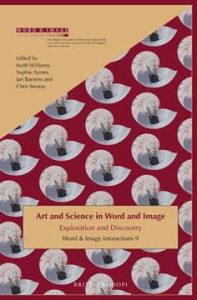
- “Photographie et théâtre”, Revue internationale de photolittérature, ed. Marianne Drugeon, Christine Kiehl, Jean-Pierre Montier et Laurence Petit, n° 2, 2018. https://www.fabula.org/actualites/revue-internationale-de-photolitterature_88524.php
- Converging Lines: Needlework in English Literature and Visual Arts edited by Rachel Dickinson & Laurence Roussillon-Constanty, Revue E-Rea, n° 16.1/2018: https://journals.openedition.org/erea/6451
- Next IAWIS Triennial Conference
CALL FOR SESSIONS Water and Sea in Word and Image, University of Luxembourg, July 5th – 10th, 2020
In an era in which water scarcity is threatening us all and the mainland is affected even in the depths of its epicenter by what is happening on its shores, it seems of great importance to propose a subject both acutely topical and strongly tied to the collective imagination. In Alessandro Baricco’s novel Ocean sea (1993), the fictional character Plasson paints the sea with seawater. This emblematic scene sums up our topic to some extent: water is difficult to grasp and yet concerns us more and more. Shapeless, still waiting to be defined, it even resists any effort of conceptualization. Putting water and the sea into words and into images is not obvious, represents a real discursive and plastic challenge and is therefore particularly likely to call into question the relationship between text and image. Due to its rhythm “without measure” (Deleuze & Guattari, 1980), water as an element transcends Lessing’s dichotomy between arts of time and arts of space (see Louvel, 2002). The water’s unspeakable nature does not coincide with its invisible essence. Yet, literary and plastic narratives constitute an actual semiosphere with, at its borders, an area where the semiotic links are violated (Lotman, 1966), the realm of the unstable, the arbitrary, the unaccountable.
Located at the heart of the European continent – however tightly interconnected with its periphery –, cradle of the siren Melusine, territory boasting its natural springs and its balneology, Luxembourg seems to be the appropriate place to host a world congress on this subject.
Abstracts for sessions should be a maximum of 300 words.
N.B.: All conference participants must be members of IAWIS/AIERTI (http://iawis.org/) and in order with their membership fee before the conference.
The deadline for SESSION PROPOSALS is February 28th, 2019. Submissions are to be dropped on our website: https://waterandsea2020.uni.lu
The selection committee will contact you before March 30th, 2019 about the outcome of your application.
POTENTIAL CONFERENCE SESSION THEMES
N.B.: The sessions consist of one or maximum two panels of 1h30 each (three papers). The panels will offer a tribune to experienced researchers in Word and Image Studies and/or young scholars (doctoral students/postdocs) whose proposals the chairs of the elected sessions will gather and select. The word and image interaction should be formulated in the title of the session. Please indicate if your session fits with one or several of the potential themes listed below (e.g.: 1, 7, 12).
- Water, a natural element (its virtues and dangers) and an esthetic challenge
- Water as energy in science and arts
- The biblical or mythical imaginary of water and sea
- Aquatic and maritime myths, rites and marine, fluvial or lacustrine folklore
- Melusine, nymphs, naiads and other sirens
- The seaside or still water in painting and literature
- Balneology, its history and actuality
- Harbours in texts and images
- Insular or peninsular cultures
- Touristic promotion of natural heritage (seaside, lakes, rivers)
- Aqueducts, thermal baths and dams in the Greater Region
- The Mediterranean Sea, the Atlantic and the Pacific Ocean (shores, fauna, cultural and market routes, migration)
- Graphic novel, comics or cartoons on sea, water or migration
- Water and sea in film, video or in digital artefacts
- The future of water in arts and media
- Water scarcity, drought and sustainable issues in word and image
- The sea as epistemological metaphor (shipwreck, raft, wave, hurricane, liquidity, archipelago, foam)
- Scientific or imaginary cartography
- Other related topics
AHNCA
The Association of Historians of Nineteenth-Century Art (AHNCA) is pleased to announce that the Sixteenth Annual Graduate Student Symposium in the History of Nineteenth-Century Art, co-sponsored by AHNCA and the Dahesh Museum of Art, will be held on Sunday, March 24, 2019 (10:00 am – 5:00 pm), at the Dahesh Museum of Art, 145 Sixth Ave., New York, NY. The Mervat Zahid Cultural Foundation has generously provided the Dahesh Museum of Art Prize of $1,000 for the best paper. Information about the speakers and brief abstracts of their papers will be available online at http://ahnca.org/index.php/symposia after February 6, 2019.
Historians of German, Scandinavian, and Central European Art and Architecture (HGSCEA)
The Board recently awarded travel stipends to two members of HGSCEA, Sara Blaylock and Lauren Hanson, to help defray the costs of their participation in CAA’s annual conference. The Board also juried this year’s HGSCEA Emerging Scholars Prize competition, the winner of which will be announced at the reception and dinner in New York. As always, the dinner, which will take place on Thursday, February 14, from 7 to 9 p.m., is free to current members. For further information, contact a member of the Board.
HGSCEA’s sponsored session at the annual CAA conference, “Women Artists in Germany, Scandinavia, and Central Europe, 1880-1960,” is being chaired by Kerry Greaves on Saturday, February 16, from 10:30 a.m. to 12:00 p.m.. Emil Leth Meilvang, Nora Butkovich, Lauren Hanson, and Lynette Roth will read papers on Rita Kernn-Larsen, women in the Young Yiddish Group, Mary Bauermeister, and Anneliese Hager. For more information, go to the HGSCEA website (http://hgscea.org/ ) and the conference website (https://caa.confex.com/caa/2019/meetingapp.cgi/Session/1607)
The annual business meeting is scheduled for Friday, February 15. It will take place in the Harlem Room on the 4th Floor of the New York Hilton Midtown from 12:30-1:30 p.m. Members are welcome to attend.
The Midwest Art History Society
The Midwest Art History Society (MAHS) would like to call your attention to its recent e-publication Monumental Troubles: Rethinking What Monuments Mean Today, searchable by its title in WorldCat. The publication records selected papers presented at the 2018 MAHS Annual Conference held in Indianapolis. The essays in this e-volume contribute to contemporary conversations about public monuments, broadly defined as commemorative objects, images, and spaces, and the responses to them, including the calls to remove, relocate, or destroy them. Contributors consider these “monumental troubles” from multiple historical, geographic and theoretical perspectives, suggesting a generative rethinking about why they were made and how their meaning changed over time.” The original conference sessions were organized by Erika Doss, University of Notre Dame and the publication effort was guided to its successful conclusion by Cheryl Snay of the Snite Museum of Art.
And please consider attending the 2019 MAHS Annual Conference to be held in Cincinnati, March 21-23. The Cincinnati Art Museum & the Taft Museum of Art are conference hosts, keynote speaker is Hollis Clayson. Conference registration includes special tours, receptions, and more. Reduced fees for early registration end on March 1. Book a room in the Hilton Netherland Plaza at a discounted rate before Feb 27. Click the link below to register online & book a room. https://www.mahsonline.org/conference/register
HNA
What: CAA session: The Female Impact: Women and the Art Market in the Early Modern Era
When: Thursday, February 14, 2019, 2:00 PM – 3:30 PM
Where: New York Hilton Midtown – 2nd Floor – Morgan Suite
CHAIRS: Judith Noorman and Frans Grijzenhout
What: HNA Reception
When: Friday, February 15, 2019, 5:30-7 pm
Where: Syracuse University Lubin House, 11 East 61st Street, New York, NY
Please RSVP to Amy Golahny, Golahny@Lycoming.edu
EPCAF
The European Postwar and Contemporary Art Forum has changed its governance structure and will now be headed by a team of co-chairs. Lily Woodruff has transitioned from her previous role as president, and is now joined by Raffaele Bedarida. Raffaele is an art historian and curator specializing in twentieth-century Italian art and politics. In particular, his research has focused on cultural diplomacy, migration, and cultural exchange between Italy and the United States. He is an Assistant Professor of Art History at Cooper Union, New York. Bedarida is the author of two monographs in Italian, Bepi Romagnoni: Il Nuovo Racconto (Milan: Silvana Editoriale, 2005) and Corrado Cagli: La pittura, l’esilio, L’America (Rome: Donzelli, 2018; English edition upcoming), and numerous articles for academic journals (International Yearbook of Futurism Studies, Oxford Art Journal, Tate Modern’s In Focus) and exhibition catalogues (MART, Rovereto; CIMA, New York; Fundacion Juan March, Madrid; Frederick Kiesler Foundation, Vienna). He holds a PhD from the Art History Department of the CUNY Graduate Center, as well as MA and BA degrees in Art History from the Università degli Studi di Siena, Italy. Bedarida is currently working on the manuscript for his book: ‘Like a Giant Screen:’ The Promotion of Contemporary Italian Art in the United States, 1935–1969.
Public Art Dialogue (PAD)
Public Art Dialogue (PAD) will present its 2019 PAD Award for achievement in the field of public art to art collective fierce pussy during next week’s conference. Please see the announcement here: https://publicartdialogue.org/news/2019-01-09/2019-pad-award-fierce-pussy
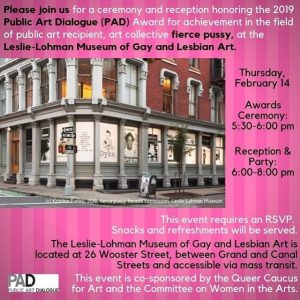
Comprehensive Appraisal Studies Program (CASP)
Now Accepting CASP Applications!
The Appraisal Institute of America, the educational foundation of the Appraisers Association of America is now accepting applications for our Comprehensive Appraisal Studies Program (CASP) for both the Summer 2019 and Fall 2019/Spring 2020 Semester.
Enroll in CASP to learn to appraise the fine and decorative arts. Completing CASP will provide you with a certificate in Appraisal Studies from the Appraisal Institute of America.
For more information and to apply, please visit our website at www.appraisersassociation.org/CASP.
Society of Architectural Historians
The Society of Architectural Historians has been awarded a two-year, $508,000 grant from The Andrew W. Mellon Foundation to study the status of the field of architectural history in higher education. The grant provides support for a data-gathering initiative that will gauge the health of architectural, urban and landscape history as fields of study, as well as degree programs and curricula across the higher education landscape. SAH plans to hire a post-doctoral researcher to design and manage the study to determine where, and in what ways, these fields of study are expanding, receding, changing, or holding steady and to consider the structural or cultural factors behind such trends. SAH also will hire a Project Coordinator to assist with the project. Visit the SAH Career Center for full job descriptions.
SAH has named architect Aymar Mariño-Maza and architectural historian Zachary J. Violette as the recipients of the 2018 H. Allen Brooks Travelling Fellowship. The fellowship allows an emerging scholar to travel the world to experience architecture and landscapes firsthand. SAH awarded Mariño-Maza a one-year fellowship and Violette a short-term fellowship for three months of travel. They will begin their fellowship travels in March 2019 and will document their field studies through monthly updates on the SAH Blog.
SAH invites nominations and self-nominations for the next Editor of the Journal of the Society of Architectural Historians. JSAH is a quarterly, blind-peer reviewed international journal devoted to all aspects of the history of the global built environment and spatial practice, including architecture, landscape architecture, urbanism, and city planning. Published since 1941, JSAH has defined the field of architectural history, and is a pioneer in digital publication. Nominations due by April 30, 2019.
Association of Print Scholars
The Association of Print Scholars is pleased to host its affiliated society panel at the College Art Association conference on Friday, February 15, 2019 in New York.
Chaired by Christina Michelon (University of Minnesota, Twin Cities), Coloring Print examines global printmaking traditions that advance our understanding of the role of the medium in the social construction of race. The papers chosen include “Red Ink: Ethnographic Prints and the Colonization of Dakota Homelands” by Annika Johnson (University of Pittsburgh); “Sites of Contest and Commemoration: The Printed Life of Richard Allen, America’s Early Race Leader” by Melanee C. Harvey (Howard University); “A Franco-Indian Album: Firmin Didot’s Indian Paintings and Le Costume Historique’s Chromolithography (1888)” by Holly Shaffer (Brown University); and “The White Native Body in Asia: Woodcut Engraving and the Creation of Ainu Stereotypes” by Christina M. Spiker (St. Catherine University).
Aaron M. Hyman and Dana Leibsohn have been awarded the Association of Print Scholars 2018 Publication Grant to support the forthcoming publication related to their project “Washing the Archive: Indigenous Knowledge, European Prints, and Colonial Histories of Latin America.”
The co-authored project focuses on the circulation of prints in colonial Latin America, highlighting unpublished documents and the methodological provocations indigenous practices can offer traditional early modern print histories. The funding supplied by the grant will provide both authors the opportunity to travel to the Library of Congress and to the University of Virginia to complete their study of indigenous uses of European prints in Spanish America, especially practices of re-use, circulation, and loss under colonial conditions. The $2,000 award is funded by the Association of Print Scholars and through the generosity of C.G. Boerner and Harris Schrank. We thank both print dealers for their support of APS and its mission.
SOCIETY OF HISTORIANS OF EASTERN EUROPEAN, EURASIAN, AND RUSSIAN ART AND ARCHITECTURE (SHERA)
The following members were elected to the SHERA Board: Kristin Romberg (Vice President/President Elect); Corina Apostol (Web News Editor); and, Anna P. Sokolina (SHERA-SAH Liaison). Karen Kettering now serves as President, Alice Isabella Sullivan as Secretary-Treasurer, and Yelena Kalinsky as Listserv Administrator.
Aglaya K. Glebova (UC-Irvine) has been awarded the SHERA Emerging Scholar Prize for her essay “Elements of Photography: Avant-garde Aesthetics and the Reforging of Nature” (Representations 142, Spring 2018). Ekaterina Heath (University of Sydney) was selected as the recipient of the SHERA Travel Grant for CAA 2019 to will deliver her paper entitled “Picturing the Cathay in Russia: Political use of Chinoiserie interiors under Empress Elisabeth Petrovna and Emperor Peter III.”
The generous anonymous donor who has funded the SHERA Travel Grant has increased their support to allow for more grants and to enlarge the pool of eligible applicants. The award was initially given out once per year, for travel to CAA and ASEEES conferences in alternate years and was limited to graduate students. Going forward, the Travel Grant will be awarded twice per year for travel to both CAA and ASEEES. Additionally, independent scholars who receive no institutional support are now eligible to apply. US-based scholars will receive $1,000 and scholars traveling from outside the US will receive $1,500. Calls for applications are published on H-SHERA and on CAA Opportunities.
SHERA’s Board would like to continue developing online resources for scholars and teachers in our field using the H-SHERA platform, including book reviews, sample syllabi, up-to-date contact information for obtaining image permissions, conference reports, information about graduate programs, or other resources. If you have ideas or would like to volunteer to help with this effort, please write to the H-SHERA editors at editorial-shera@mail.h-net.org.
Association of Art Museum Curators (AAMC) & AAMC Foundation
Association of Art Museum Curators (AAMC) & AAMC Foundation is currently accepting applications for its Conference Travel Fellowships for curators to attend its Annual Conference and Meeting. Since 2010 alone, over 200 individual Curatorial Travel Fellowships have been awarded.
This year we are proud to offer two opportunities:
- Conference Travel Fellowship for Junior Curators. Open to junior curators with less than ten years of experience. Funding generously provided by the Samuel H. Kress Foundation.
- Art Fund / AAMC Conference Travel Fellowship. Open to UK curators to travel, network and develop relationships with their international peers. These Fellowships are a collaboration between Art Fund and AAMC Foundation.
All applicants must commit to participating in the full Conference program (May 4-7, 2019 in New York City) at the time of application, including the all deadlines (non-negotiable), timelines, and travel. A stipend is granted as part of this Program to subsidize the travel requirements. Multiple curators from one museum are eligible, though individuals may only submit one application per year.
Each Fellowship has a separate application, and members may apply to one Fellowship only. Applications for both of these AAMC Foundation Conference Travel Fellowships are due via our online application portal by 12pm ET on Tuesday, February 12, 2019.
To view the full program benefits, eligibility, and the link to the applications, please visit:
https://www.artcurators.org/page/TravelGrants
—-
Association of Art Museum Curators (AAMC) Foundation is pleased to announce Digital & Outward Engagement, the next installment in its regional In-Conversation series. Launched in 2016, AAMC Foundation’s In-Conversation series brings together local communities and expands networks.
Slated for Tuesday, February 26 at the Philadelphia Museum of Art, In-Conversation: Digital & Outward Engagement features six perspectives on building bridges between museums and their audiences through the use of ever-evolving technologies and digital tools. Moving past social media and traditional websites, this event brings together Philadelphia’s leading voices to dig deeper into the ways in which technology can help advance dialogues with visitors, donors, colleagues, and the larger global community. They will touch on the current efforts and platforms in the digital sector, and consider ways in which they could be used to help better connect with audiences. With a look at the topic from varying perspectives, we’ll also have the opportunity to reflect on ways to collaborate as well.
Moderated by Christopher D.M. Atkins, Ph.D, Agnes & Jack Mulroney Associate Curator of European Painting & Sculpture and Manager, Curatorial Digital Programs & Initiatives, Philadelphia Museum of Art, this program features Aaron Miller, Senior Producer, Digital Media, The Franklin Institute; William Noel, Associate University Librarian & Director, Kislak Center for Special Collections, Rare Books and Manuscripts Director, Schoenberg Institute for Manuscript Studies, Penn Libraries; Amy Sadao, Daniel W. Dietrich, II Director, Institute of Contemporary Art, University of Pennsylvania; Ariel Schwartz, Kathy and Ted Fernberger Associate Director of Interactive Technologies, Philadelphia Museum of Art; and Neville Vakharia, Program Director, Arts Administration Campus Program and Associate Professor and Research Director, Drexel University, Westphal College of Media Arts & Design.
This In-Conversation will be hosted at the Lecture Auditorium at the Philadelphia Museum of Art’s Perelman Building on Tuesday, February 26, 2019 from 6:30pm – 8:00pm, followed by a short reception from 8:00pm – 8:30pm. Space is limited so pre-registration is required. Click here to reserve your seat!
ACASA – Arts Council of the African Studies Association
- ACASA welcomes new board members:
Peri Klemm, President
Peju Layiwola, President Elect/VP
Shannen Hill, Past President
Raphael Chikukwa, Secretary
Rachel Kabukala, Treasurer
Fiona Siegenthaler, Newsletter Editor
Erica Jones, Assistant Website Editor
Cynthia Becker, ASA Liaison
Olubukola Gbadegesin, CAA Liaison
El Hadji Malick Ndiaye
In office since 2017:
Nadine Siegert, Website Editor & ECAS Liaison
Brenda Schmahmann, Facebook Manager
Anitra Nettleton, ASA Task Force for the Protection of Academic Freedom
Shadreck Chirikure
We thank our outgoing board members Silvia Forni, Jordan Fenton, Yaëlle Biro, Cécile Fromont, Liese Van der Watt, Deborah Stokes, Leslie Rabine and Cory Grundlach for their great work and wish them all the best for the future!
- Africa, Technology, and Visual Cultures: ACASA sponsored panel at the 107th CAA Annual Conference, NYC, February 14, 2019, 8.30-10.00am
Join us at the ACASA sponsored panel Africa, Technology, and Visual Cultures chaired by Amanda Kay Gilvin with paper contributions by Suzanne Preston Blier, Stephen Adéyemí Folárànmí, Kate Ellen Cowcher and Fiona Siegenthaler.
https://caa.confex.com/caa/
- Behind-the-Scenes at the Brooklyn Museum during 107th CAA Annual Conference, NYC February 15, 2019, 10.15am- 12.00pm
Join Kristen Windmuller-Luna, Sills Family Consulting Curator of African Arts, for a behind-the-scenes tour of the new exhibition One: Egúngún. Featuring a Yoruba (Nigerian) masquerade costume composed of over 300 African, Asian, and European textiles, the exhibition uses new research and multiple perspectives to emphasize the global connections and contemporary contexts of African masquerades. Information about the exhibition: http://brooklynmuseum.org
Limited space: RSVP at bkm.nyc/caa2019acasa
H-AfrArts is looking for Editors and Advisory Board Members to join the team and share duties and responsabilities on a voluntary basis.
The Editor role involves moderating discussion posts and general CfPs. There is also an exciting opportunity (optional) to develop new content based on your interest and initiative, such as developing Teaching and Research Resources, Conference Reports, and Cross-Network Projects. A minimum of one year committment is required for this role. For a full description of the duties of Editors please consult: https://networks.h-net.org/node/905/pages/80264/becoming-editor
The Advisory Board Members assist with the general development and welfare of the Network and advise Editors in cases in which there are disputes with the members (such as when a post is rejected and a subscriber appeals). A minimum of two years commitment is required for this role. To find out more, please visit: https://networks.h-net.org/h-net-advisory-board-members
About the Network:
H-AfrArts is an international network jointly sponsored by H-Net (Humanities Online) and ACASA (Arts Council of the African Studies Association-USA) to provide a forum for the discussion and exploration of African art and expressive culture. There are a number of reasons and benefits for joining H-AfrArts Network, these include:
Collaboration: Volunteering with an H-Net Network can be an excellent opportunity to work within a multi-disciplinary and committed editorial team.
Engagement: H-AfrArts Network provides an excellent opportunity to engage with, support, and develop your field of study.
Best Practice: H-Net is committed to supporting editorial best practices. You will receive comprehensive H-Commons online training to moderate and safeguard the content of the network.
Support: H-Net has a Home Office staffed by trained historians, an online training program, a Help Desk, and a separate space where its Editors can discuss questions and concerns relating to academic best practices and project development.
Durability: H-Net is committed to the long-term digital preservation of its academic content.
Visibility: H-Net’s content is available online for free and uses an email notification system to deliver academic content directly to subscribers.
How to Apply:
Applicants must demonstrate expertise in African Arts and have regular and reliable access to email.
If you are interested, please send your CV and a covering letter by email to: editorial-afrarts@mail.h-net.msu.edu
For any questions or help please contact: Helena Cantone – Advisory Board yenacanta@gmail.com
Applications will be accepted until the positions are filled.
This is a voluntary position: The H-Net is a non-profit organization run by academics and built around a committed community of volunteers.
- Call for Applications: AFRICAN CRITICAL INQUIRY PROGRAMME: IVAN KARP DOCTORAL RESEARCH AWARDS FOR AFRICAN STUDENTS ENROLLED IN SOUTH AFRICAN Ph.D. PROGRAMMES
Closing Date: Wednesday 1 May 2019
The African Critical Inquiry Programme is pleased to announce the 2019 Ivan Karp Doctoral Research Awards to support African doctoral students in the humanities and humanistic social sciences who are enrolled at South African universities and conducting dissertation research on relevant topics. Grant amounts vary depending on research plans, with a maximum award of ZAR 40,000.
The African Critical Inquiry Programme (ACIP) seeks to advance inquiry and debate about the roles and practice of public culture, public cultural institutions and public scholarship in shaping identities and society in Africa. The Ivan Karp Doctoral Research Awards are open to African postgraduate students (regardless of citizenship) in the humanities and humanistic social sciences. Applicants must be currently registered in a Ph.D. programme in a South African university and be working on topics related to ACIP’s focus. Awards will support doctoral research projects focused on topics such as institutions of public culture, particular aspects of museums and exhibitions, forms and practices of public scholarship, culture and communication, and the theories, histories and systems of thought that shape and illuminate public culture and public scholarship. Awards are open to proposals working with a range of methodologies in the humanities and humanistic social sciences, including research in archives and collections, fieldwork, interviews, surveys, and quantitative data collection. For full information about this opportunity and how to apply, see the full Call for Proposals listed under “ACIP Opportunities” on the website: http://www.gs.emory.edu/about/special/acip.html.
- Call for proposals to organize a workshop: AFRICAN CRITICAL INQUIRY PROGRAMME Closing Date: Wednesday 1 May 2019
The African Critical Inquiry Programme invites proposals from scholars and/or practitioners in public cultural institutions in South Africa to organise a workshop to take place in 2020. The African Critical Inquiry Programme (ACIP) seeks to advance inquiry and debate about the roles and practice of public culture, public cultural institutions and public scholarship in shaping identities and society in Africa.
ACIP Workshops are intended as annual occasions to identify and address critical themes, fundamental questions and pressing practical issues concerning public culture. For instance, Workshops might focus on particular notions and issues related to publics, visuality, museums and exhibitions, art, performance, representational forms, or institutional forms from different methodological, practical, and theoretical vantages. They might examine forms and practices of public scholarship and the theories, histories and systems of thought that shape and illuminate public culture and public scholarship. Workshops should encourage comparative, interdisciplinary, and cross-institutional interchange and reflection that brings into conversation public scholarship in Africa, creative cultural production, and critical theory. Workshop budgets will vary depending on proposed plans; the maximum award is ZAR 60,000.
Applications may be submitted by experienced scholars and cultural practitioners based in universities, museums, and other cultural organizations in South Africa who are interested in creating or reinvigorating interdisciplinary, cross-institutional engagement and understanding and who are committed to training the next generations of scholar-practitioners. Applications may be submitted by a single individual or a pair of individuals who have different institutional affiliations and bring different perspectives, approaches, or specializations to the proposed Workshop theme.
For full information about this opportunity and how to apply, see the full Call for Proposals listed under “ACIP Opportunities” on our website. A list of previously supported ACIP Workshops is also available there: http://www.gs.emory.edu/about/special/acip.html.
CWA Picks for February 2019
posted by CAA — Feb 04, 2019
CAA’s Committee on Women in the Arts selects the best in feminist art and scholarship to share with CAA members on a monthly basis. See the picks for February below.
ROSEMARY MEZA-DESPLAS: JANE ANGER
January 31 – February 24, 2019
Amos Eno Gallery, Brooklyn
“Anger is an assertion of rights and worth. It is communication, equality, and knowledge. It is intimacy, acceptance, fearlessness, embodiment, revolt, and reconciliation. Anger is memory and rage. It is rational thought and irrational pain. Anger is freedom, independence, expansiveness, and entitlement. It is justice, passion, clarity, and motivation. Anger is instrumental, thoughtful, complicated, and resolved. In anger, whether you like it or not, there is truth…If ever there was a time not to silence yourself, to channel your anger into healthy places and choices, this is it.”
Soraya Chemaly, Rage Becomes Her: The Power of Women’s Anger (2018, Atria Books)
Artist Rosemary Meza-DesPlas explores all of these elements of anger and more through her sinuous lines in hand-sewn human hair drawings, watercolors and onsite installations in her solo show, Jane Anger, the title referencing a 16th century pamphlet published in England titled Jane Anger, Her Protection for Women. She also utilizes art history as inspiration by juxtaposing found art historical imagery along with social media and mass media imagery, exploring how the social movements, Women’s Marches and #MeToo, harnessed anger in order to forefront an array of gender-based burdens, presenting anger as a tool rather than detriment, as media often reflects. Moreover, by using her own gray hair in her drawings, Meza-DesPlas implicates further thought on socio-cultural symbolism, feminism and body issues, and religious symbolism, invoking both contemporary and classical perspectives around anger. Building on the multi-media experience, during the opening reception, the artist will present her piece titled Intervals of Anger, performing a poem every fifteen minutes. Taken altogether and individually, Jane Anger will surely rile and provoke audiences on this timely issue.
HELÈNE AYLON: Elusive Silver: Paintings that Change in Time
January 12 – March 2, 2019
Leslie Tonkonow, New York
The first solo exhibition of Helène Aylon in New York since 1979, Elusive Silver is a great introduction to the perceptual intricacies and feminist intent of the work of this understudied pioneer through her eponymous 1969-1973 abstract painting series. Comprising works that reflect and refract an inner glow that changes visually with the viewer’s stance and the light conditions, this first exploration of process-driven painting made with industrial materials such as sheet metal, acrylic plastic and spray paint is a potent prelude of her signature late-1970s works physically changing, as intended, with the passage of time.
Born in 1931 and raised within the Ultra-Orthodox Jewish community in Boro Park, Brooklyn, Aylon was married to a rabbi at the age of eighteen and became widowed, with two young children, at the age of thirty. While in her mid-twenties, she enrolled as an art major at Brooklyn College, taking classes with Ad Reinhardt who became her friend, her true mentor who freed her work, while also introduced her to Mark Rothko, with whom she shared the spiritual foundations of their common cultural backgrounds. Refraining from mark-marking, beginning in 1969, however, Aylon experimented with the idea of creating “painting that revealed itself,” in an attempt to introduce an evolving feminist consciousness in painting.
The Medea Insurrection: Radical Women Artists Behind the Iron Curtain
December 8, 2018 – March 31, 2019
Kunsthalle im Lipsiusbau, Dresden, Germany
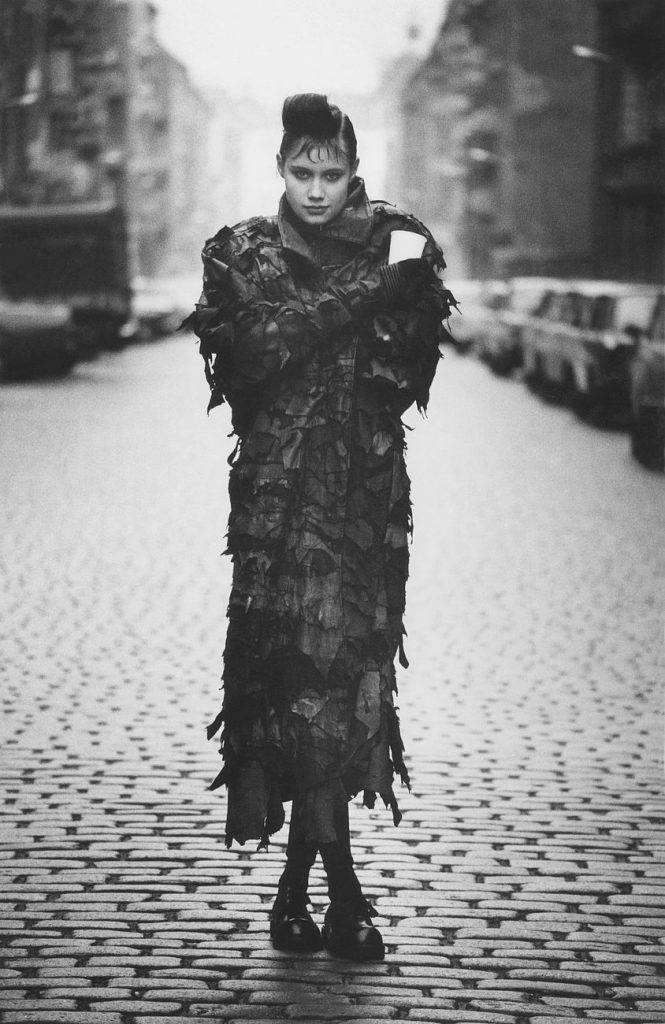
Sibylle Bergemann, Heike, Allerleirauh, Berlin, 1988, on view in The Medea Insurrection: Radical Women Artists Behind the Iron Curtain at the Kunsthalle im Lipsiusbau in Dresden, Germany, through March 31st.
Curated by Suzanne Altmann, The Medea Insurrection redresses the marginalization of the vanguard women artists working in the German Democratic Republic and their radical female perspective—largely due to the institutional predilection for East Germany’s male figurative painters before and after the Wall’s fall. The Medea Insurrection illuminates the singularly radical idioms of an intergenerational selection of multimedia women artists and rarely shown groups from East Germany and highlights their conceptual and artistic affinities with more recognized artists from other socialist countries in light of their shared provocative turn to mythology and empowering reinterpretation of female figures –such as Medea, Cassandra or Penthesilea—as means to advance contemporary, often punk, images of women, and protest both bourgeois and socialist role models. With this “double refusal” they were exposing themselves often to more risk than their male colleagues, who prior to 1989 often turned to codes of ancient mythology to express their discontent with the communist rule yet in painting. Performance artist Gabriele Stötzer, for instance, was imprisoned as a dissident and faced years of surveillance by the Stasi. Christa Jeitner too was banned from exhibiting in the 1970s, as was Cornelia Schleime who fled to the West in 1981.“From a lack of freedom, a certain freedom emerges,” as put by the curator, who argues that women artists were often more radical in such contexts of artistic unfreedom—perhaps because they were working so far under the official radar that they could take greater risks.
The exhibition brings together the work of rarely shown performance and fashion group Allerleihrauh, the visual dissidence of Dresden artists Angela Hampel, Christine Schlegel, Cornelia Schleime and Karla Woisnitza, the feminist experimentations of the filmmakers’ group Efurt, from Thuringia, an intergenerational mixture of East Berlin photographers such as Gundula Schulze Eldowy, Tina Bara, Evelyn Richter and Sibylle Bergemann, as well as Christa Jeitner and performance artist Gabriele Stötzer with Magdalena Abakanowicz (Poland), Geta Bratescu (Romania), Katalin Ladik (Hungary), Zofia Rydet (Poland), Zorka Saglova (Czech Republic) and Alina Szapocznikow (Poland), among others, capturing, their defiant risk taking, talent for improvisation, self-irony, and categorical reinterpretation of classical materials and motifs across their different media. It also draws parallels to the 1980s, when Else Gabriel (Germany) and Hanne Wandtke (Germany) carried out risky performance experiments as part of the Dresden group Autoperforationsartisten.
I Wish to Communicate With You: Corita Kent and Matt Keegan
January 13 – April 14, 2019
Potts Gallery (Los Angeles)
Some conversations are historical-actual—often resulting in the production of treasure troves of personal material (letters and/or gifts exchanged as signs of connection and engagement)—and other conversations must, by dint of our temporal realities, be virtual. When Corita Kent died in 1986, Matt Keegan was only ten years old—yet this did not stop the young artist from finding a point of contact in Kent’s work. On sabbatical in Cape Cod Kent produced a series of work that melded the color-combinations of naval signal flags with a variety of source material (the book of revelation, Winnie the Pooh, and others) to create a vibrant abecedarium. Years later, Keegan has taken Kent’s historical work and created his own series based on the radical juxtapositions offered by the former nun. Bringing the two together in virtual dialogue is a reminder as to how artist’s trajectories extend far past their own lives, and how we might continue to have conversations with the past.
Graciela Iturbide’s Mexico
January 19 – May 12, 2019
Museum of Fine Arts, Boston
Born in Mexico City in 1942, Graciela Iturbide has spent her career photographing daily life for the variety of indigenous populations that live in Mexico, and Latin America more broadly. A mentee of Manual Álvarez Bravo—who taught at the Universidad Nacional Autónoma de México (UNAM), where Iturbide attended—her work is both a paean to, and departure from Bravo’s exacting formalism. In the late 1970s Iturbide received two important commissions, both to photograph segments of Mexico’s many indigenous communities. These commissions resulted in the publication of Juchitán de las Mujeres, a defining moment in Iturbide’s storied career. Her engagement with matrilineal and matriarchal indigenous communities, not to mention the presence of the Zapotec genderqueer muxe, meant that Iturbide’s photography has necessarily engaged questions of gender, sex, and social cohesion. As Iturbide’s prominence increased, she was invited to devise and complete projects all over the world – yet this exhibition makes a case for Mexico as the near-constant geographic touchstone running throughout her practice.
New in caa.reviews
posted by CAA — Feb 01, 2019
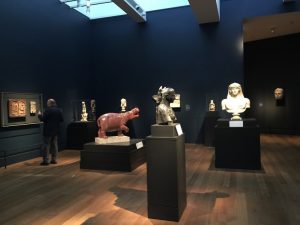
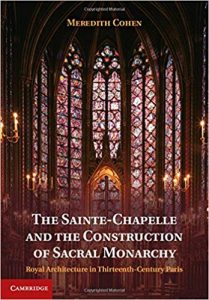 Cynthia Colburn reviews Beyond the Nile: Egypt and the Classical World by Jeffrey Spier, Timothy F. Potts, and Sara E. Cole. Read the full review at caa.reviews.
Cynthia Colburn reviews Beyond the Nile: Egypt and the Classical World by Jeffrey Spier, Timothy F. Potts, and Sara E. Cole. Read the full review at caa.reviews.
Emily Davenport Guerry writes about The Sainte-Chapelle and the Construction of Sacral Monarchy: Royal Architecture in Thirteenth-Century Paris by Meredith Cohen. Read the full review at caa.reviews.



